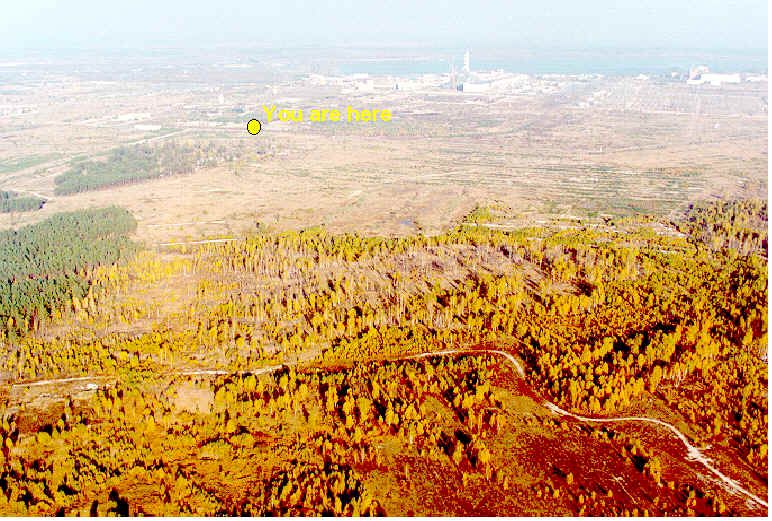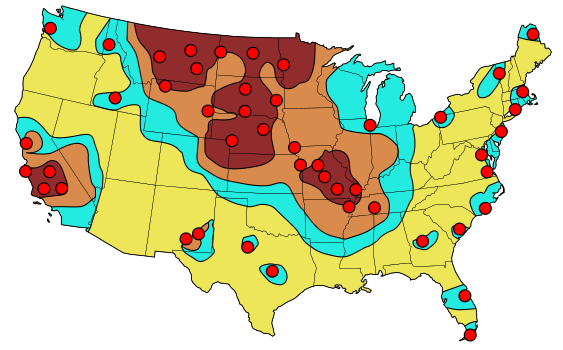
Blog
-
Geiger Readings for March 19, 2014
Ambient office = 69 nanosieverts per hourAmbient outside = 123 nanosieverts per hourSoil exposed to rain water = 102 nanosieverts per hourBanana from QFC = 94 nanosieverts per hourTap water = 75 nanosieverts per hourFiltered water = 68 nanosieverts per hour -
Nuclear Accidents 27 – The Dead Forest around Chernobyl
Many fairy tales and legends feature a haunted forest. The trees are twisted into grotesque shapes and strange creatures roam there. It appears as if we are on the way to having a real haunted forest in the area around Chernobyl where the environment was heavily contaminated with radiation from the accident that happened there in 1986. A sudden power surge during testing destroyed a reactor causing a huge explosion. No people live in the exclusion zone around the destroyed nuclear power station but plants and animals are still showing the effects of radiation poisoning almost thirty years after the accident. It has been found the brains of birds in around Chernobyl are smaller than normal, fewer insects live in that area, trees are growing slower and big game animals that leave the exclusion zone still have high levels of radiation.
A recent report about the biology around Chernobyl suggests that the organisms that usually decompose organic matter are affected by the high levels of radiation. Natural recyclers such as microbes, fungi and some insects are less capable of consuming and reducing dead organisms. For instance, there is a pine forest near Chernobyl where all the trees turned read and died shortly after the accident. These trees do not seem to be decomposing and there is increasing litter of dead leaves and pine needles on the forest floor. It turns out that the litter is much deeper in areas where the radiation level is highest.
In order to determine whether or not radiation was responsible for the lack of decomposition, the researcher put different types of leaves in mesh bags, some line with a fine mesh to keep insects out. The bags were distributed around Chernobyl in areas with different levels of radiation. After a year, the bags were collected to see what had happened. Where t here was no radiation, most of the leaves disappeared during the year-long test. Where there was a lot of radiation, over fifty percent of the leaves survived for the whole year. Comparing the two sizes of mesh, it was found that microbes and fungi play a much larger role in the decomposition of leaves than insects do. Because the bags had been placed in a lot of different conditions, the researchers were able to eliminate anything other than radiation as the cause of the lack of decomposition.
The researched concluded that it was damage to microbes that resulted in slower or no decomposition around Chernobyl. They also thought that it was probable that the slower return of nutrients to the soil was the cause of slower tree growth.
The dead trees and leaf clutter on the forest floor is also poses an increased risk of wildfires. In addition to the damage usually caused by wildfires, such fires around Chernobyl could cause a redistribution of radioactive contamination as dust and smoke from the fires could escape the exclusion zone. The researchers are collaboration with other scientists in Japan to see if a similar zone lacking microbial life forms around the Fukushima nuclear power plant.
Chernobyl Red Forest:
-
Geiger Readings for March 18, 2014
Ambient office = 101 nanosieverts per hourAmbient outside = 87 nanosieverts per hourSoil exposed to rain water = 109 nanosieverts per hourBanana from QFC = 84 nanosieverts per hourTap water = 100 nanosieverts per hourFiltered water = 91 nanosieverts per hour -
Nuclear Weapons 67 – Ukraine and Nuclear Weapons
I grew up during the Cold War and, as a child, had nightmares of nuclear war. As the Cold War wound down and the nuclear powers agreed to reduce their nuclear arsenals, I thought that I could relax a bit. Now there are people on both sides of the Earth who would like to restart the Cold War.
When the Cold War ended, Ukraine had Soviet nuclear missiles. They decided that they did not want to be a nuclear power and sent the missile to Russia to be dismantled. They obtained a treaty signed by the U.S., the UK, and Russia that Ukraine would be defended by the other signatories of the treaty if threatened by a nuclear power. Just last year, China signed a similar treaty with Ukraine.
Due to the current situation with Russia on the verge of annexing Crimea, some Ukraine officials have said that it might be desirable for Ukraine to obtain nuclear weapons to protect itself. It is an interesting question of how far the U.S., the UK or China would be willing to go to protect Ukraine against Russian aggression.
Recently a news anchor in Russia who appears on the network that is essentially a propaganda wing of the current Russian government said that Russia was the only country that could reduced the United States to radioactive ash in a matter of hours. Recently, a Russian general appeared on Russian TV with an animation showing Russian missiles attacking the U.S. Another Russian General said that there is an automatic system in place that could fire Russian missiles from silos and submarines even if the Russian government had been destroyed in a nuclear attack. Chinese generals have also been talking about nuclear war with the U.S. China has been accusing Japan of planning to create nuclear weapons.
The Unites States and Russia both have around fifteen hundred nuclear missiles aimed at each other. There are protocols in place to launch those missiles within minutes in case of war. There are estimates that the explosion of around a hundred nuclear warheads may be sufficient to cause a nuclear winter that would end human civilization. In a nuclear war, no one wins.
We are now in the most tense international situation with Russia since we experienced the Cuban Missile Crisis in 1973. During that crisis a Soviet ship had navigational problems and crossed the red line created by the U.S. A U.S. naval captain had orders to fire on any Russian ship that crossed that line. If the captain had fired, it might have started a nuclear war. He hesitated long enough to verify that the Russian ship had strayed off course. The fate of the world rested with one man. There have been other close calls during the years of the Cold War.
There are those voices in the U.S. that say that we should take a hard line with Russians over Crimea and even consider military options. I am really afraid that if we do anything like that, we could be on a slippery slope to nuclear war and the end of human civilization. The chancellor of Germany recently said, after talking to Putin, that he was out of touch with reality. If there is any truth to this, the world is entering a very dangerous time.
FEMA-estimated primary counterforce targets for Russian ICBMs. The resulting fall-out is indicated with the darkest considered as “lethal” to relatively fall-out free yellow zones:
-
Radiation News Roundup March 17, 2014
Nuclear Nation a haunting documentary about the Fukushima meltdown. newyorker.com
Monitoring following an incident at a Halifax, Canada, port suggests that containers of uranium hexafluoride dropped by a crane Thursday are not leaking. nuclearstreet.com
A nuclear dump in Western Pennsylvania could contain far more waste than originally thought, the Nuclear Regulatory Commission’s inspector general said in a new report. observer-reporter.com
-
Geiger Readings for March 17, 2014
Ambient office = 89 nanosieverts per hourAmbient outside = 109 nanosieverts per hourSoil exposed to rain water = 77 nanosieverts per hourAsparagus from Central Market = 110 nanosieverts per hourTap water = 146 nanosieverts per hourFiltered water = 130 nanosieverts per hour -
Geiger Readings for March 16, 2014
Ambient office = 89 nanosieverts per hourAmbient outside = 109 nanosieverts per hourSoil exposed to rain water = 77 nanosieverts per hourAsparagus from Central Market = 110 nanosieverts per hourTap water = 146 nanosieverts per hourFiltered water = 130 nanosieverts per hour





